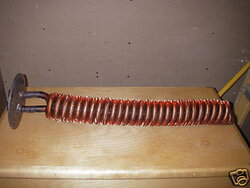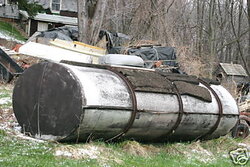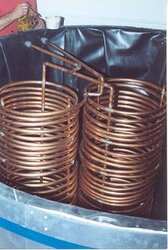Setting up my EKO 40 super, and a 1600 gallon tank this summer,
A guy on youtube talked about his storage tank having a "bun" in it
I'm thinking tube "bun"dle, but he sent a closed ebay auction ID to me, and said he didn't know the manufacturer, but it looked like this
Any help would be appreciated. I'm also open to other suggestions on immersion type heat exchange.
My 1600 gallon tank is a horizontal oval, 11 feet long, 4 feet high, by 6.5 feet wide. Access is through a manhole on top, and it has one drain on the bottom.
Material of construction is 304 or 316 stainless steel.
Thanks for any help
Here is the pic of a "bun" I guess... and the tank is the one I picked up this past weekend. It was a bulk milk transfer tank for the dairy industry. The dark blocks on the outside of the tank are old cork insulation, which is now scraped off, and the Carbon Steel rings and strips are for stregenthing, and insulation support. the tank it's self is smooth polishied and open inside, very nice. it had some brushed on coating/adhesive to hold the insulation, but it comes off with solvent pretty good, so I can clean it up if I wanted too. it's at least .100 to .125 wall thickness, so quite sturdy, but not too heavy.
Andy
A guy on youtube talked about his storage tank having a "bun" in it
I'm thinking tube "bun"dle, but he sent a closed ebay auction ID to me, and said he didn't know the manufacturer, but it looked like this
Any help would be appreciated. I'm also open to other suggestions on immersion type heat exchange.
My 1600 gallon tank is a horizontal oval, 11 feet long, 4 feet high, by 6.5 feet wide. Access is through a manhole on top, and it has one drain on the bottom.
Material of construction is 304 or 316 stainless steel.
Thanks for any help
Here is the pic of a "bun" I guess... and the tank is the one I picked up this past weekend. It was a bulk milk transfer tank for the dairy industry. The dark blocks on the outside of the tank are old cork insulation, which is now scraped off, and the Carbon Steel rings and strips are for stregenthing, and insulation support. the tank it's self is smooth polishied and open inside, very nice. it had some brushed on coating/adhesive to hold the insulation, but it comes off with solvent pretty good, so I can clean it up if I wanted too. it's at least .100 to .125 wall thickness, so quite sturdy, but not too heavy.
Andy




